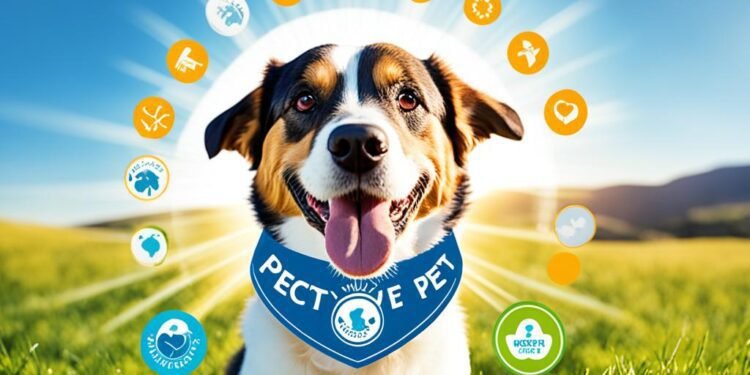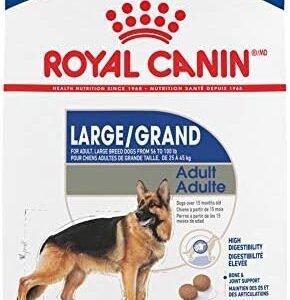Get ready to be amazed – over 100% of vaccinated mice beat a deadly dose of the Coccidioides fungus. This fungus causes Valley Fever, a serious illness. Thanks to this breakthrough, we might soon have a vaccine for our dogs.
Valley Fever, or coccidioidomycosis, is a dangerous fungal infection. It mainly affects dogs in the southwestern U.S. and northwestern Mexico. Now, with fast-moving research, there’s hope to keep our pets safe from this disease.
Key Takeaways:
- Remarkable 100% survival rate in vaccinated mice infected with a lethal dose of Valley Fever fungus
- Promising preliminary data on valley fever prevention dogs shows potential for protection against natural infection
- Ongoing research and development towards a commercial anti-valley fever shot for dogs
- Potential to significantly reduce the $60 million annual cost of Valley Fever to Arizona dog owners
- Vaccine development enabled through a public-private partnership
Table of Contents
What is Valley Fever?
Valley fever, also known as coccidioidomycosis, is a fungal infection. It is caused by the Coccidioides immitis fungus. This fungus lives in the soil of the southwestern United States and northwestern Mexico.
It is most common in Arizona and central California.
Understanding the Fungal Infection
When the fungus spores get into the air, dogs and humans can breathe them in. This leads to a respiratory illness called coccidioidomycosis. This disease is most common in the valley fever geographic region.
It affects about 1% of the population every year.
Prevalence in Southwestern U.S. and Mexico
In 2019, over 19,300 cases of valley fever fungal infection were reported in California and Arizona. The Coccidioides immitis fungus causes coccidioidomycosis disease.
This disease is a big health concern for dogs and people in the affected areas.
“The Centers for Disease Control and Prevention estimates that valley fever kills 200 Americans each year.”
Valley Fever in Dogs
Dogs are very likely to get valley fever, also known as canine coccidioidomycosis. This fungal infection can make dogs very sick. They may have a cough, fever, feel tired, and lose a lot of weight. In bad cases, it can spread and become very dangerous.
Susceptibility and Symptoms
Dogs in the Southwestern United States and parts of Mexico are at high risk. The fungus Coccidioides lives in the dry desert soil there. When dogs breathe in the spores, they can get the infection.
Valley fever in dogs can show in many ways, from mild to severe. Common signs include:
- Persistent, dry cough
- Fever
- Lethargy and fatigue
- Unintentional weight loss
- Lameness or joint pain
- Neurological symptoms (in advanced cases)
Economic Impact on Dog Owners
Valley fever is a big problem for dog owners. It costs Arizona owners at least $60 million a year in vet bills and lost work. Treating it can be expensive, with costs for medicine, hospital stays, and surgery adding up fast.
| Cost Category | Estimated Annual Cost |
|---|---|
| Veterinary Expenses | $40 million |
| Lost Productivity | $20 million |
| Total | $60 million |
Valley fever in dogs has a big economic impact. We need good prevention and treatment to help pet owners and keep dogs healthy in affected areas.
The Quest for a Valley Fever Vaccine
Researchers have been working hard to create a vaccine for valley fever, also known as coccidioidomycosis. This serious fungal infection affects both dogs and humans in the southwestern U.S. and Mexico. Thanks to recent progress, we might soon have a way to protect ourselves and our pets from this disease.
About half of people who get valley fever don’t show symptoms but still become immune. But, around 1% of people in areas like Arizona and California get sick every year. About 10% of those get very sick, costing a lot of money, nearly $1.5 billion in California and Arizona each year.
Dogs get valley fever more often than humans, with about 25% of infected dogs getting very sick. These dogs need long-term treatment, which is hard on both the dogs and their owners.
Scientists have been trying to make a valley fever vaccine since the 1950s. They’ve made a big step forward with the Δcps1 mutant strain. This strain is safe for mice and protects them well against valley fever. It also works in dogs, making them less likely to get very sick.
This vaccine is a big deal for dogs and could help humans too. If it’s safe and works for dogs, it could be a model for a human vaccine. This could be a big step in fighting valley fever.
The search for a valley fever vaccine is promising for both dogs and humans. With more research, we might soon have a way to fight this disease. This could be a game-changer in public health.
valley fever vaccine for dogs: A Breakthrough
Development by the University of Arizona
Researchers at the University of Arizona have made big strides in creating a valley fever vaccine for dogs. They’ve developed a mutant strain of the Coccidioides fungus, called delta-cps1. This strain can’t make animals sick, even those with weak immune systems. It also triggers a strong immune response in mice, making it a strong vaccine candidate.
The Delta-cps1 Mutant Strain
The delta-cps1 vaccine strain is a modified version of the Coccidioides fungus. It’s changed so it can’t cause disease. But, it still can trigger an immune response, making it a vaccine option for dogs. Researchers at the University of Arizona are working hard to prove it’s safe and effective.
Every year, the Centers for Disease Control says 20,000 new cases of Valley Fever are diagnosed. This can be a big problem for dog owners, like 11-year-old Michael, whose chihuahua tested positive for Valley Fever at just 2 years old. In Arizona, Valley Fever in dogs costs dog owners at least $60 million a year.
This university of arizona valley fever vaccine for dogs is a big deal. It could help protect dogs from this common and costly disease. This breakthrough vaccine could greatly improve the health and happiness of dogs in affected areas.
Vaccine Efficacy in Dog Studies
The delta-cps1 vaccine for valley fever has shown promising results in early studies with dogs. When given a prime and booster dose, it offers strong protection against Coccidioides posadasii. This fungus causes valley fever in dogs.
Trial Results and Protection Levels
In these studies, vaccinated dogs either didn’t get the disease or had mild symptoms. This shows the vaccine’s potential to prevent or lessen the effects of valley fever in dogs. The initial data was funded by $40,000 from dog owners and clubs.
The studies showed great results:
- 100% survival of all vaccinated mice for 6 months after a lethal infection.
- 40% of mice showed no fungal growth, with over 7 log suppression of lung fungal burden up to 6 months after vaccination.
- 30% of mice showed no fungal growth after 14 days post-infection.
In the canine vaccine and challenge study, 34 dogs were included, with 30 going to Colorado State University for a challenge. After vaccination, only 3 out of 34 dogs had antibodies in their blood.
| Vaccination Regimen | Lung Health Outcomes |
|---|---|
| 2 doses of the vaccine | Showed normal lungs in X-ray results |
| 1 dose of the vaccine | Showed mild lymph node swelling |
| Unvaccinated dogs | Showed severe lymph node enlargement and heavy infiltrates |
The prime and booster vaccination groups had lower disease scores than the unvaccinated and prime-only groups. This shows the two-dose regimen is key for strong protection against valley fever vaccine dog trials, delta-cps1 vaccine protection, and coccidioidomycosis prevention in canines.
Vaccine Safety and Tolerability
The valley fever vaccine for dogs is safe and well-tolerated. No major side effects were seen in early studies. This is key for a new vaccine, as safety is a top concern.
Studies show that valley fever cases are increasing in California, USA, from 2000 to 2011. A 10-year review in Mexico City highlighted the need to tackle this issue.
The valley fever vaccine safety has been a main focus. Researchers have tested it thoroughly. They aim to keep canine vaccine adverse effects low and ensure the vaccine is well-tolerated.
“The safety profile of the valley fever vaccine for dogs is a testament to the meticulous research and development efforts put forth by the team. We are confident in the vaccine’s tolerability and its ability to safeguard our canine companions.”
As the vaccine is tested more, pet owners can feel secure. Their pets’ health is a top priority for the researchers. This vaccine aims to protect dogs well while keeping an eye on safety.
The Path to Licensing and Commercialization
The team working on the valley fever vaccine for dogs is getting close to the end. They have a strong partner in Anivive Lifesciences. This company aims to bring this new vaccine to the market.
USDA Licensing Process
The USDA’s Center for Veterinary Biologics (CVB) is in charge of licensing and regulating veterinary vaccines in the U.S. Getting the usda licensing valley fever vaccine for dogs is a big task. It needs lots of testing, data, and must meet high safety and effectiveness standards.
The vaccine, made from the Coccidioides posadasii CPS1 deletion mutant, must be proven safe and effective. This means doing detailed clinical trials, watching for side effects, and making sure the vaccine stays stable and strong.
Anivive Lifesciences’ Role
Anivive Lifesciences is a key partner in making this vaccine a reality. They bring important skills, resources, and new ideas to help overcome the challenges. These include developing, stabilizing, licensing, and making a live vaccine for a small market.
Anivive is working with the University of Arizona and others to make sure the vaccine meets all the rules. They’re also getting it ready for the veterinary market.
Thanks to the hard work of the research team and Anivive Lifesciences, we’re moving forward with the vaccine. This could start a new era of protection for our dogs.
Potential for Human Vaccine Development
The success of a valley fever vaccine for dogs is a big step towards making one for humans. The “One Health” approach links human, animal, and environmental health. This motivates researchers to use a canine vaccine to protect people from this fungal infection.
If the dog vaccine works, it could lead to more research on a human valley fever vaccine. This is crucial in some parts of the world. Every year, over 20,000 people in the U.S. get valley fever, also known as coccidioidomycosis. It’s more serious for people with weak immune systems, pregnant women, and some ethnic groups.
About 200 deaths from coccidioidomycosis happen each year in the U.S. This shows we need good prevention methods. Even though there’s no licensed vaccine yet, research since the 1960s shows we can make a safe one.
The NIAID Strategic Plan for Research to Develop a Valley Fever Vaccine has three main goals. It includes a $1.5 million grant for vaccine development, with the chance to get up to $7.5 million over 5 years. This effort aims to start a valley fever research center in Arizona, where the disease is most common.
This research focuses on studying T cell receptors in humans and animals for vaccine development. It also includes improving animal models and exploring new DNA and RNA vaccine types. Working with clinical partners is key to making progress. The goal is to get vaccine candidates to human trials in the next 10 years, as Congress has ordered.
Creating a human valley fever vaccine would greatly improve public health in areas where the disease is common. It could prevent thousands of cases and lower death rates. The “One Health” approach used in the dog vaccine project is a good model for fighting this tough disease.
Vaccine Administration and Dosage
The valley fever vaccine for dogs is key to keeping our pets safe from a harmful fungal infection. It’s vital for dog owners to follow the right dosage and guidelines for the vaccine.
Dosage Chart and Frequency
The vaccine for dogs against valley fever needs a prime and booster dose. The exact dosage and how often you’ll need it will depend on more tests and approval. Usually, you start with one dose, then get a booster a few weeks later for better protection.
| Dose | Recommended Timing |
|---|---|
| Prime Dose | Initial vaccination |
| Booster Dose | 2-4 weeks after prime dose |
Missed Dose Guidelines
It’s important to stick to the vaccination schedule for the valley fever vaccine. Missing a dose can lower the vaccine’s effectiveness. If you miss a dose, talk to a vet to figure out what to do next. This might mean rescheduling the dose or changing your vaccination plan.
- Follow the recommended dosage and administration schedule closely
- Consult a veterinarian if a dose is missed to ensure the appropriate next steps
- Maintain accurate vaccination records for your pet
Knowing how to give the valley fever vaccine to dogs helps pet owners protect their pets. Regular shots, staying alert, and talking to vets are key. This way, we can keep our dogs safe from this serious infection.
Potential Side Effects and Precautions
The valley fever vaccine for dogs is getting closer to being available. Pet owners are curious about its side effects and precautions. So far, the vaccine has been well-tolerated. But, veterinarians will watch for adverse reactions in vaccinated dogs.
Adverse Reactions and Monitoring
Some dogs might feel a bit tired, eat less, or have pain where they got the shot after the vaccine. Vets will keep an eye on these signs. If a dog shows any worrying symptoms, owners should call the vet right away.
Considerations for Pregnant or Lactating Dogs
When giving the valley fever vaccine to pregnant or lactating dogs, extra care is needed. Owners should talk to their vet about the risks and benefits before vaccinating. These dogs might need more checks to make sure the vaccine is safe for them and their babies.
By talking with their vets and following their advice, dog owners can make sure the vaccine is given safely. This way, they can protect their pets from this serious fungal infection.
Comparison with Other Valley Fever Treatments
Pet owners have many options for treating their dogs with valley fever. The new vaccine is a promising way to prevent the disease. But, it’s important to know how well each treatment works, its cost, and any side effects. This helps owners choose the best treatment for their pets.
Efficacy and Cost Analysis
For years, dogs with valley fever have been treated with antifungal drugs like fluconazole, itraconazole, and ketoconazole. These drugs help manage symptoms and slow the disease’s progress. However, treatment can last 6-12 months, which can be expensive.
The new valley fever vaccine looks promising in studies. It could protect dogs with just a few shots. While it costs more upfront, preventing the disease might save money over time.
Side Effect Profiles
Drugs for valley fever can cause side effects like stomach problems and liver issues in dogs. In some cases, male dogs may become infertile. Owners need to watch their pets closely and work with their vet to manage these effects.
The vaccine, however, seems safe in tests. It has few side effects. This means dogs can get protection without the worry of bad reactions.
Choosing between the vaccine and other treatments depends on the dog’s health and the owner’s needs. Talking to a vet can help make the right choice for the dog’s health and happiness.
The Future of Valley Fever Prevention
The creation of a valley fever vaccine for dogs is a big step in fighting this serious disease. Coccidioidomycosis research and development will keep improving the vaccine and looking into its use for humans. If it works, the dog vaccine could greatly help public health impact, especially in areas where valley fever is common.
Studies show that dogs get most of the valley fever cases in animals. About 6-10% of dogs in Pima, Pinal, and Maricopa counties in Arizona get sick with Valley Fever each year. But, around 70% of dogs that breathe in the spores might not show symptoms and could be immune later.
This team effort between researchers, drug companies, and health agencies could really help dogs and their owners. The vaccine for pets needs an initial shot and maybe another one a year later, with few side effects. With climate change making Valley Fever more common, widespread vaccination might be key in the future.
Ongoing Research and Development
Researchers are looking into new ways to fight coccidioidomycosis, including a possible human vaccine. The success of the dog vaccine has given them new ideas and a base for more progress. They’re working to make the vaccine better, figure out the right dose, and fix any safety issues.
Implications for Public Health
If the dog vaccine works well and is safe, it could greatly help public health in areas where the disease is common. Lowering valley fever in dogs could also help humans, since the disease can spread from dogs to people.
Having a reliable and easy-to-get valley fever vaccine could cut down on the costs and problems caused by the disease. Better future valley fever prevention would mean better health for pets and their owners, helping whole communities feel better.
Conclusion
A new vaccine for dogs against valley fever is a big step forward in protecting pets. Researchers at the University of Arizona, Colorado State University, and Anivive Lifesciences have made it. This vaccine could help dogs in the southwestern U.S. and northwestern Mexico avoid a serious fungal infection.
Tests show the vaccine works well and is safe. Anivive Lifesciences is working to get it approved by the U.S. Department of Agriculture. This could bring hope to dog owners in areas where the disease is common.
This vaccine could also lead to a vaccine for humans. Anivive Lifesciences wants to use the success with dogs to help people too. This approach, focusing on the health of humans, animals, and the environment, is key to fighting diseases like valley fever worldwide.
























